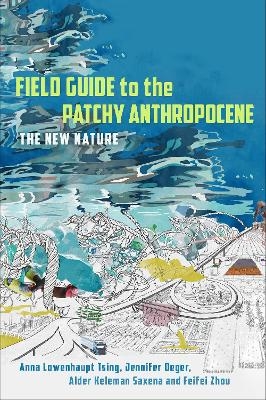
Field Guide to the Patchy Anthropocene
Stanford University Press (Verlag)
978-1-5036-3732-0 (ISBN)
While the global scientific community recently made headlines by ruling the Anthropocene—an era many date to the Industrial Revolution when human action truly began to transform the planet—did not qualify for a geological epoch quite yet, understanding the nature of human transformation of the Earth is more important than ever. The effects of human activity are global in scope, but take shape within distinct social and ecological "patches," discontinuous regions within which the key actors may not be human, but the plants, animals, fungi, viruses, plastics, and chemicals creating our new world. Field Guide to the Patchy Anthropocene takes stock of our current planetary crisis, leading readers through a series of sites, thought experiments, and genre-stretching descriptive practices to nurture a revitalized natural history.
Field guides teach us how to notice, name, and so better appreciate more-than-human worlds. They hone our powers of observation and teach us to see the world anew. Field-based observations and place-based knowledge cultivation—getting up-close and personal with patchy dynamics—are vital to truly grapple with the ecological challenges and the historical conjunctures that are bringing us to multiple catastrophic tipping points. How has commercial agriculture runoff given rise to comb jellies in the Black Sea? What role did the Atlantic slave trade play in the worldwide spread of virus-carrying mosquitoes? How did the green revolution transform the brown planthopper into a superpredator in Philippine rice fields? Questions like these open up new ways of understanding, and ways of living through, the epoch that human activity has ushered in.
This Field Guide shifts attention away from knowledge extractive practices of globalization to encourage skilled observers of many stripes to pursue their commitments to place, social justice, and multispecies community. It is through attention to the beings, places, ecologies, and histories of the Anthropocene that we can reignite curiosity, wonder, and care for our damaged planet.
Anna Lowenhaupt Tsing is Distinguished Professor of Anthropology at the University of California, Santa Cruz and the author of The Mushroom at the End of the World. She is also a Professor at Aarhus University. Jennifer Deger is Professor of Digital Humanities and Co-Director of the Centre for Creative Futures at Charles Darwin University, Australia. Alder Keleman Saxena is Assistant Professor in the Department of Anthropology and Program in Sustainable Communities at Northern Arizona University. Feifei Zhou is Adjunct Assistant Professor in Architecture at Columbia University Graduate School of Architecture, Planning and Preservation. Together they are coeditors of Stanford's digital publication Feral Atlas: The More-than Human Anthropocene (2020).
Introduction
PART I. Patches
1. Bringing Field Observation to the Anthropocene
2. What Makes a Patch?
3. Mapping the Patch
Part II. Ruptures
4. Hotspots in the Patchy Anthropocene
5. Unseasonal Weather
6. How to Detonate an Anthropocene
Part III. Histories
7. Others Without History
8. What Is History?
9. Histories of the Future
Part IV. Epistemics
10. Piling
11. Building and Unbuilding
12. Beyond Piling
Appendix: Feral Atlas and Field Guide
| Erscheinungsdatum | 24.04.2024 |
|---|---|
| Zusatzinfo | 68 halftones |
| Verlagsort | Palo Alto |
| Sprache | englisch |
| Maße | 152 x 229 mm |
| Themenwelt | Naturwissenschaften ► Biologie ► Ökologie / Naturschutz |
| Sozialwissenschaften ► Ethnologie | |
| Sozialwissenschaften ► Soziologie | |
| ISBN-10 | 1-5036-3732-8 / 1503637328 |
| ISBN-13 | 978-1-5036-3732-0 / 9781503637320 |
| Zustand | Neuware |
| Haben Sie eine Frage zum Produkt? |
aus dem Bereich


